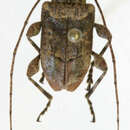Leptostylopsis humerofulvus: Brief Summary
provided by wikipedia EN
Leptostylopsis humerofulvus is a species of longhorn beetles of the subfamily Lamiinae. It was described by Lingafelter and Micheli in 2009.
- license
- cc-by-sa-3.0
- copyright
- Wikipedia authors and editors
Description
provided by Zookeys
Description. Length: 7.5-12.0 mm; width: 3.0-4.5 mm.
Head: Covered throughout in dense, appressed, mottled tawny, white, and ochraceous pubescence, with exception of narrow, median-frontal line extending from fronto-clypeal margin to between lower eye lobes and short, glabrous frontal-genal line extending from anterior tentorial pits along anterior margin of genae, to base of mandible. Pubescence on frons and vertex much finer than that on genae. Antenna: covered with dense, appressed, mottled white, tawny, and dark brown pubescence; annulate at apex and base of most antennomeres with exception of scape and usually antennomeres 2 and 3. Last antennomere uniformly dark in females, without annulae, similar in color to apex of penultimate antennomere; in males, antennae uniformly light or slightly paler at base than apex. Antennae long; typically extending beyond apices by 5-6 antennomeres in males and 4-5 in females. In both sexes, last antennomere shorter than penultimate. Antennal scape extending to posterior 1/3 of pronotum. Eye: lower eye lobe slightly less than height of gena below it; over 2 × height of upper eye lobe; lobes connected by 5-6 rows of ommatidia in most specimens. Upper eye lobes very close together, separated by much less than greatest width of scape. Mouthparts: frontoclypeal margin with fringe of short pubescence extending about halfway to base of labrum; clypeus without pubescence except at extreme base. Labrum covered with short, mostly appressed, white or ochraceous pubescence with 8-10 long, suberect, translucent setae.
Thorax: Pronotum with very slightly protuberant, broadly rounded lateral margins with greatest projection at middle; weakly raised dorsal tubercles with following arrangement: oval, partially denuded prominence at middle, surrounded by four weakly elevated tubercles (two anterolateral and two posterolateral). Pronotum without signifi cant anteromedial elevation at margins. Pronotum mostly covered in appressed, ochraceous pubescence (and to a lesser extent, white pubescence), median region darker due to combination of translucent and less dense pubescence revealing dark brown integument. In some specimens, darker central region with some iridescent green pubescence. Pronotum with moderate constriction before anterior and posterior margins, constrictions (particularly posteriorly) lined with row of separate, large punctures. Smaller punctures scattered over pronotal disk, some obscured by pubescence. Prosternum smooth, impunctate, covered with uniform, appressed, ochraceous or tawny pubescence. Prosternal process very broad between procoxae, about equal to width of procoxa in most specimens. Scutellum moderately to densely tawny or ochraceous pubescent (occasionally with white pubescence at apex); broadly rounded posteriorly. Mesosternum smooth, impunctate, covered with uniform, appressed pubescence, nearly as dense on anterior 1/3 which is deeply constricted. Mesosternal process between mesocoxae broad, separating mesocoxae by about 1.2 × width of mesocoxa. Metasternum and lateral thoracic sclerites covered with mottled, appressed, white and ochraceous pubescence. Elytra: covered with combination of mostly appressed, ochraceous, white, tawny, iridescent green, and black pubescence. Ochraceous pubescence of same color as pronotum forms distinct band on basal 1/5 of elytra. Darker, often triangular region of sparser, more translucent setae behind band. Small black macula near suture postmedially. Elytral margin dark along scutellum. Rows of small, ochraceous pubescent tubercles generally along costae, absent along suture. Tubercles at base of elytra most prominent. Humeri projecting very slightly, with dark basal margin, without distinct macula. Epipleuron dark brown at anterior 1/2, with ochraceous pubescence at apical 1/2. Elytral apex transversely truncate, with outer apical angle equally or less produced posteriorly than sutural angle. Legs: mostly uniformly pubescent with appressed hairs (white, tawny, and ochraceous), somewhat mottled; apex and basal 1/3 of tibiae annulate due to less dense pubescence exposing darker integument. Tibiae approximately equal in length to femora; hind legs much longer than forelegs; metafemora extending to about middle of ventrite 5. Base of tarsomeres generally covered with short, appressed pubescence similar in color to remainder of legs; apex of fifth tarsomere (and sometimes 1 and 2) sparsely pubescent, dark.
Abdomen: Ventrites covered with mottled, appressed, off -white and ochraceous pubescence. Fifth ventrite of females about 2 × as broad as long; weakly narrowed or extended at middle, with glabrous midline at base, extending toward apex for 1/3 or more of overall length.
- bibliographic citation
- The genus Leptostylopsis of Hispaniola (Coleoptera, Cerambycidae, Acanthocinini)
Distribution
provided by Zookeys
Distribution. Endemic to Hispaniola, this species is known only from the Cordillera Central and Barahona Peninsula of the Dominican Republic (Map 10).

